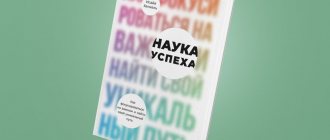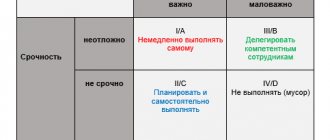Stop multitasking
Multitasking is not the super ability to do several things at the same time, but just constantly switching from one thing to another. For example, preparing a report, simultaneously checking email and responding to colleagues in the work chat.
According to the study Multitasking: Switching costs of the American Psychological Association, multitasking reduces productivity by 40% and interferes with concentration.
Due to constant switching between tasks, we feel tired and exhausted at the end of the day, although we have not accomplished everything we planned.
Multitasking is harmful not only at work, but also in everyday life. Instead of paying attention to one thing, we try to do everything at once. For example, we solve work issues over dinner, and while walking with our child we scroll through social media feeds.
To reduce the overall level of chaos and not feel like a squeezed lemon at the end of the day, learn to immerse yourself in the activity and do it mindfully. For example, if you are walking, observe the scenery, smells, sounds, and if you are having dinner with your family, enjoy good company, the taste of food and a pleasant atmosphere.
Food
The Slow Food movement teaches people not to eat on the go and to appreciate the culture of family feasting. Many are already accustomed to snacking on fast food, doing it on the run, eating a business lunch in 15 minutes and buying ready-made meals for dinner. Do we enjoy this kind of food? No. Benefit? Much less than cooked at home and eaten at a relaxed pace. Of course, you shouldn’t turn every meal into a feast, but by focusing on the taste of the food and the process, you can get more pleasure. Therefore, at least a couple of times a week it is worth getting together at the family table to chat and enjoy delicious home-cooked food. And think of its preparation as creativity!
Include fun things in your schedule
Sometimes there is no time in life for anything other than work. We put aside our favorite activities and hobbies for a while in order to finish a project, submit quarterly reports, or simply look like a superhero in the eyes of others. But this is a trap: by giving up enjoyable activities that energize us, we drive ourselves into a funnel of exhaustion.
The funnel of exhaustion is a situation when there is nothing left in life except work and daily routine.
We constantly give away energy without replenishing it, and at some point we reach rock bottom: we feel apathy, hopelessness and indifference to everything.
To get out of the funnel, schedule time for relaxation and favorite activities. For example, on Wednesday, Saturday and Sunday you set aside an hour for sports, on Friday you meet with friends after work. This is not a waste of time, but something that fills you with energy and restores mental balance.
Trips
Slow travel suggests not running from one attraction to another, but slowly enjoying new places and culture, communicating with residents, and trying local cuisine. Proponents of the destination argue that the too fast travel available today significantly reduces the enjoyment of travel. This dulls the impressions, deprives the opportunity and desire to delve deeply into the local culture, to get acquainted with the society and its features hidden at first glance.
Photo — flytothesky.ru
Switch to a flexible work schedule
According to the World Health Organization's Mental Health in the Workplace, inflexible working hours are one of the risk factors that threaten a person's mental health. That’s right: the fear of being late only increases stress. You feel this most strongly in a metropolis during rush hours, when there are traffic jams everywhere, crowding in the subway and crowded streets.
Flexible hours or remote work solve the problem, although they are not available to everyone. Try to negotiate with your manager to change your work hours. For example, make the beginning and end of the day flexible: come to work from 9 to 12, leave from 18 to 22. If your profession allows, you can work remotely from home or the nearest coworking space.
The pace of life of city residents is increasing by 1 percent per year: psychologists have made interesting conclusions
But without participation in it today it is impossible to achieve success, especially in a metropolis. More and more modern cars, trains and planes are appearing. If earlier this or that task could be completed in a week, now one day is enough. Today in Moscow, tomorrow in Paris, the day after tomorrow in New York. This rhythm of life is a common occurrence for a modern business person.
Whether this is good or bad is a separate conversation. Much depends on the person himself. Some people in this bustle feel like a fish in water, while others are more suited to the calm flow of life in a provincial town. That's not what this is about. Just the other day, another study was released confirming the idea that life is moving faster and faster. Even 10 years ago, California State University professor Robert Levine proved that the pace of life of a city can be determined by measuring the speed of movement of its inhabitants. From a psychological point of view, pedestrian speed is not an objective indicator, but a subjective one. It is determined in their heads, according to ideas about where and how much they should rush and how quickly they should do all their business.
Richard Wiseman, a professor of psychology at the University of Hertfordshire, recently conducted a similar study. He also took as a basis the idea that measuring the average speed of a person on foot allows us to understand and assess the state of the physical and social health of the city. The author of the study and his colleagues measured the average speed of pedestrians in 32 cities around the world. He visited all these cities, in each of which he asked 35 adult volunteers to overcome a distance of 18 meters. He then compared these data with values recorded ten years ago in a similar study by R. Levine.
As it turned out, over the past 10 years the average pedestrian speed has increased by about 10 percent. According to experts, technological progress, especially the Internet and mobile phones, makes people walk faster. All these achievements of civilization make it easier for people to communicate and make it more accessible. And at the same time they encourage us to be more active, impatient, and constantly do something to achieve our goals. “We are in contact with more and more people and spend minutes, not hours, communicating with them. It makes us think that everything is happening here and now,” says R. Wiseman.
These trends are most pronounced in Asian countries, which are sometimes aptly called “tigers of economic growth.” There, the average speed of human movement has increased by 20-30 percent compared to the 90s of the last century. Singapore is recognized as the champion in terms of speed of residents. Apparently, people there don’t just walk, but move in small bursts. Next come the residents of Copenhagen. The Danes, contrary to the stereotype about the slowness and calmness of the northern peoples, are only slightly inferior in speed to the small, agile Asians. The third fastest growing city is Madrid. Cities traditionally considered “high-speed” showed moderate growth in their indicators. New York was in eighth place, London in twelfth, and Tokyo in sixteenth. In Britain, London turned out to be the fastest city - it took 12th place in the ranking, Scottish Edinburgh was in 20th place and Cardiff in Wales was in 31st. And Berlin's pedestrians, according to this entertaining speed ranking, rank 4th in Europe and 7th in the world. It takes the average Berlin pedestrian as much as 11 seconds to cover the test distance of 18 meters.
The most peaceful cities in the world are at the bottom of the list. These are Blantyre Limbe in southern Malawi and the capital of Bahrain, Manama. Malawi is a country in southeast Africa. This is an economically backward agricultural country, dependent mainly on the former metropolis of Great Britain and South Africa. There is simply nowhere to rush there - except perhaps to work in neighboring countries. Labor migration to Malawi is becoming increasingly serious. Bahrain, on the contrary, is a rich country. This is an island state in South-West Asia, actively developing through the export of oil and natural gas. In terms of per capita income, it ranks fourth in the Arab world. One Bahraini citizen earns about $11,400 per month. Bahrain thrives due to tourism - Europeans flock to this country, which is considered one of the “oases of Western civilization” among its Islamist neighbors. It turns out that local residents don’t need to rush - everything is already there, which means why strive for success?
Russia does not appear in this ranking. But, presumably, Moscow and several large cities are getting closer to European “speed standards”. In the outback they still live in a “sleepy kingdom”, that is, in terms of pedestrian speed they are closer to outsiders Malawi and Bahrain. But the reasons that prevent our citizens from developing mobility, alas, are more likely to suggest a backward African country than a prosperous oil exporter. Although, based on the amount of mineral reserves, we should long ago be living no worse than Bahrain. If not better.
However, haste, as mentioned above, is not always good. According to R. Wiseman, “people experience more stress and are in a hurry more often, spending less time with friends and acquaintances.” “They don’t have time for physical education and sports, they eat worse, but they drink more and smoke more often.” “It is these factors that create health risks,” the expert believes. If everything continues at the same pace, then by 2040 we will arrive earlier than we leave, he sneers. What’s especially sad is that the lion’s share of time is taken up by useless things. According to HR specialists, we spend up to 40 percent of our working time chatting with colleagues and having unhelpful meetings. But, alas, these are the trends of the digital age... To avoid this, R. Wiseman advises overly rushed citizens to take measures to limit the impact of fuss on their lives. For self-control in an ever-accelerating world, the professor recommends that city residents constantly notice whether they are the first to finish eating, whether they are upset if they have to trail behind those in front on the street, whether they leave the store at the sight of the slightest line.
This increase in speed is affecting more people than ever before because for the first time in history, most of the world's population lives in cities,” he added. After all, the pace of life increases precisely in megacities, where people all over the world flock in search of a better life. According to the UN, by the end of 2007 half the world's population will move to cities. This means there will be even more people in a hurry.
Be in nature
Nature has a therapeutic effect on us: fresh air helps cope with stress and fatigue, physical activity energizes Influence of Acute High-Intensity Aerobic Interval Exercise Bout on Selective Attention and Short-Term Memory Tasks, and natural sounds reduce It's true: The sound of nature helps us relax tension level. To relax, you don’t have to go out of town - a city park or a shady square with a fountain will do.
If your day at work starts off stressful, go to the park during your lunch break. Regular walking will replace physical exercise and redirect your attention from work problems to relaxing objects around you.
Don't teach your children to rush
One of the most useful inventions of the slow living movement is “slow parenting.”
According to its supporters, parents who turn their child’s life into endless visits to clubs, auditions and all kinds of competitions are following the wrong path.
It is much more useful to devote time to communicating with your child, during which you can find out what is really interesting to your child, and then there will be no need to waste your time and the child’s life on activities that are not interesting to him.
Watch your breath
There are situations when there are too many irritants nearby: someone’s phone vibrates, endless notifications come in instant messengers, and colleagues confuse your thoughts with their conversations.
The tension rises, and you realize that you are about to break. In such a situation, you need to turn your attention to breathing.
The effectiveness of this way to calm down has been scientifically proven. Biochemists from Stanford University have proven The Effect of Diaphragmatic Breathing on Attention, Negative Affect and Stress in Healthy Adults that there is a relationship between the depth of breathing and emotions: the faster and shallower a person breathes, the higher the degree of anxiety and tension. Deep and slow breathing relaxes and relieves tension.
A television
Slow television was born in Norway: instead of constantly changing pictures, there were programs without cuts, for example, watching the movement of a train or ship. I found a video on the Internet of a train that takes you around Norway. The spectacle is amazing. I recommend to all! You can watch endlessly.
In Belarus you can make the same video and enjoy. There is nothing complicated, all you need is a camera and the desire to slow down.
This direction is opposed to the high rhythm of presenting material on television: oversaturation of news releases, round-the-clock live news broadcasts, fast “clip” editing, too detailed coverage of events, and frequent advertising. Supporters of the trend believe that this negatively affects TV viewers and interferes with the correct perception of information










